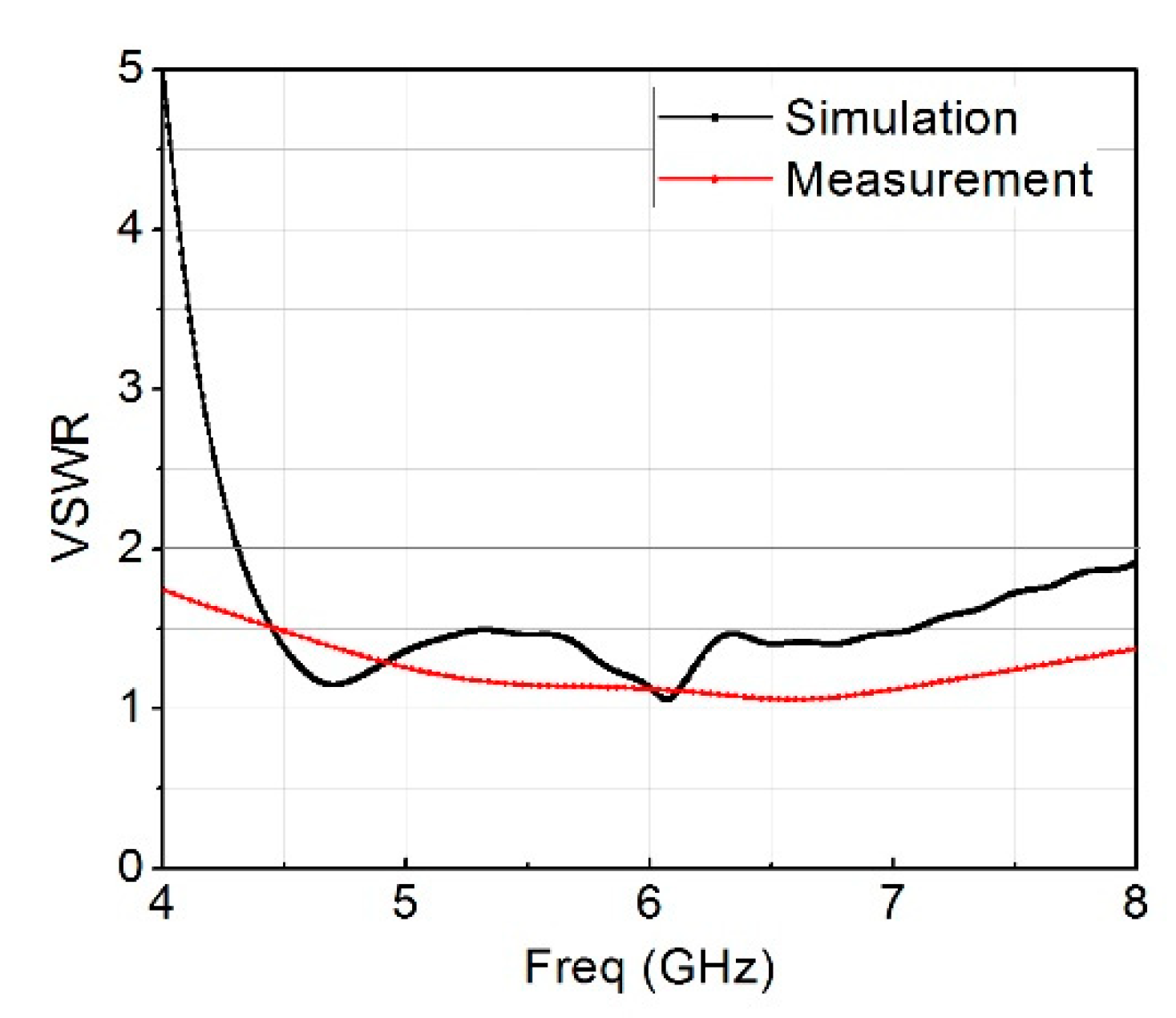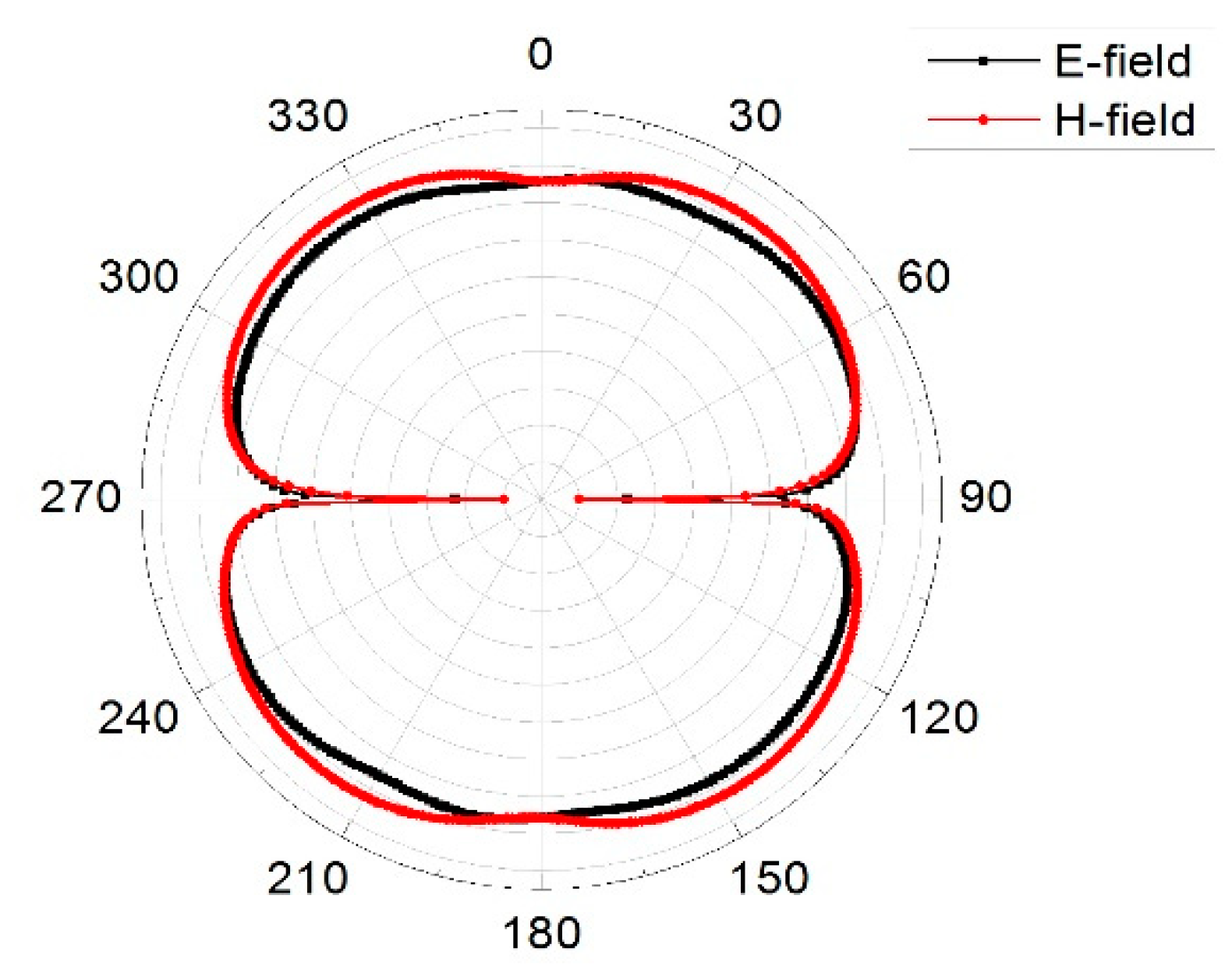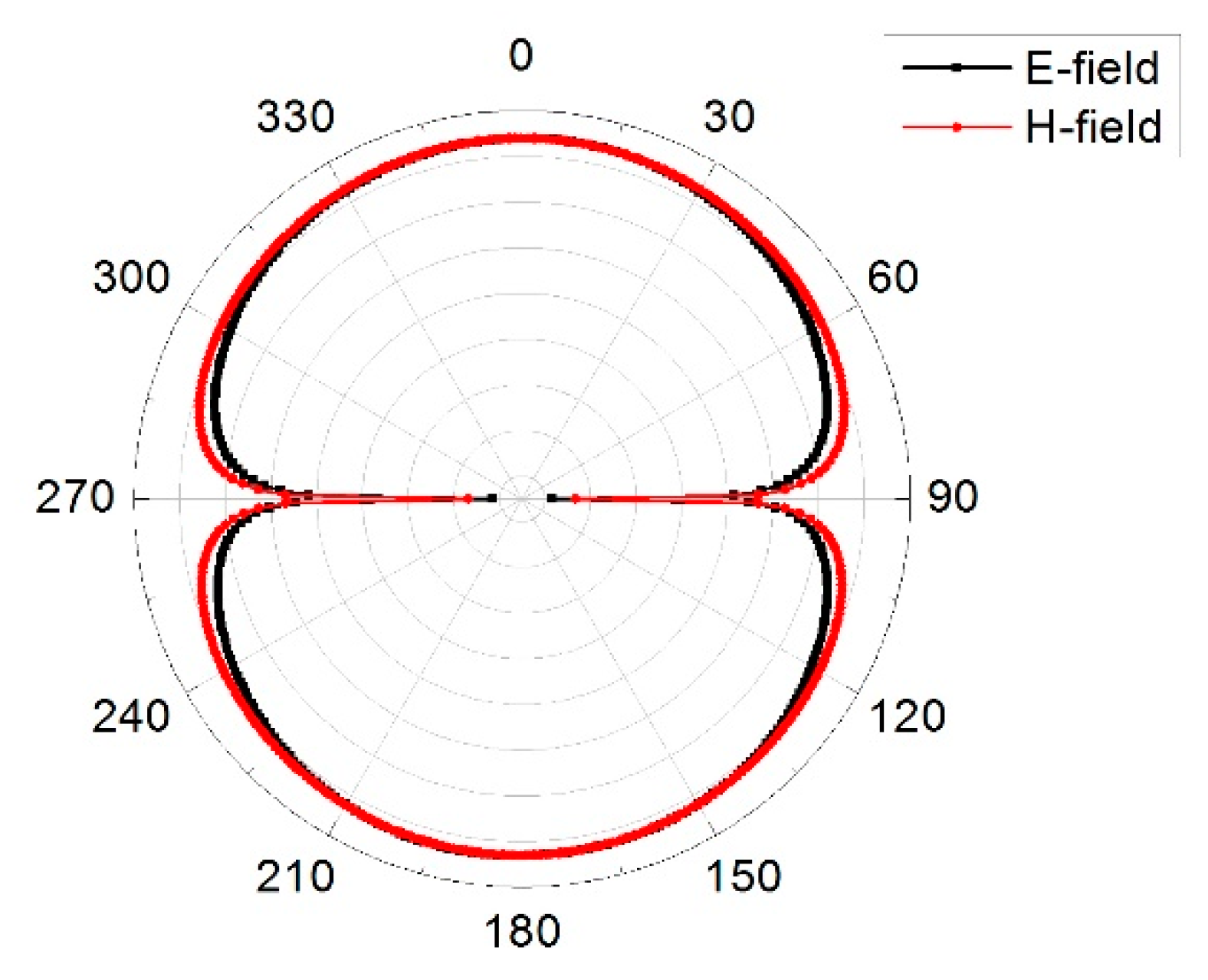Characteristic Mode Analysis and Design of Wide Band MIMO Antenna Consisting of Metamaterial Unit Cell
Abstract
:1. Introduction
- A full wave simulation tool was used to analyze the performance of MIMO antenna.
- A technique that utilizes metamaterial unit cell structure was developed with the aim of increasing isolation between MIMO radiating elements.
- More than 25 dB of isolation was achieved in the design considered.
- Used a characteristic mode to offer physical insight about antenna operating principles and to find the resonating frequency of specific modes.
- Construction and measurement of a MIMO antenna to verify the design concept and to confirm the simulated results.
2. Parametric Analysis of the Design
3. Antenna Design and Simulation Using Full Wave Simulation
4. Characteristic Mode Analysis of the MIMO Antenna
5. Diversity analysis of the MIMO antenna
6. Conclusions
Author Contributions
Funding
Conflicts of Interest
Abbreviations
| MIMO | Multiple-Input-Multiple-Output |
| CMA | Characteristic mode analysis |
| LTE | Long term evolution |
| WIMAX | Worldwide interoperability for microwave access |
| CSRR | Complementary split ring resonator |
| VSWR | Voltage standing wave ratio |
| MTM | Metamaterial |
| MS | Modal significance |
| ECC | Envelope correlation coefficient |
| DG | Diversity gain |
| BW | Bandwidth |
| GSM | Global system for mobile |
| LTE | Long term evolution |
| WLAN | Wireless local area network |
References
- Wu, Y.; Ding, K.; Zhang, B.; Li, J.; Wu, D.; Wang, K. Design of a compact UWB MIMO antenna without decoupling structure. Int. J. Antenna Prop. 2018, 2018. [Google Scholar] [CrossRef]
- Ali, W.A.E.; Ibrahim, A.A. A compact double-sided MIMO antenna with an improved isolation for UWB applications. Int. J. Electron. Commun. 2017, 82, 7–13. [Google Scholar] [CrossRef]
- Li, K.; Shi, Y. Wideband MIMO handset antenna design based on theory of characteristic modes. Int. J. RF Microw. Comput. Aided Eng. 2018, 28. [Google Scholar] [CrossRef]
- Abiodun, O.; Yang, H.; Wu, Y. Enhancing the security of wireless communication with the aid of guard nodes. J. Commun. 2016, 11, 586–591. [Google Scholar] [CrossRef]
- Christos, M.; Michail, M. Space-constrained massive MIMO: Hitting the wall of favorable propagation. IEEE Commun. Lett. 2015, 19, 771–774. [Google Scholar] [CrossRef]
- Kundu, L. Information Theoretic Limits on MIMO Antennas. Ph.D. Thesis, North Carolina State University, Raleigh, NC, USA, 2016. [Google Scholar]
- Qian, K.-W.; Huang, G.-L.; Liang, J.-J.; Qian, B.; Yuan, T. An LTCC interference cancellation device for closely spaced antennas decoupling. IEEE Access 2018, 6, 68255–68262. [Google Scholar] [CrossRef]
- Iqbal, A.; Saraereh, O.A.; Ahmad, A.W.; Bashir, S. Mutual coupling reduction using F-shaped stubs in UWB-MIMO antenna. IEEE Access 2018, 6, 2755–2759. [Google Scholar] [CrossRef]
- Luo, C.-M.; Hong, J.-S.; Zhong, L.-L. Isolation enhancement of a very compact UWB-MIMO slot antenna with two defected ground structures. IEEE Antennas Wirel. Propag. Lett. 2015, 14, 1766–1769. [Google Scholar] [CrossRef]
- Lee, C.H.; Chen, S.Y.; Hsu, P. Integrated dual planar inverted F antenna with enhanced isolation. IEEE Antennas Wirel. Propag. Lett. 2009, 8, 963–965. [Google Scholar]
- Dabas, T.; Gangwar, D.; Kumar, B.K.; Gautam, A.K. Mutual coupling reduction between elements of UWB MIMO antenna using small size uniplanar EBG exhibiting multiple stop bands. Int. J. Electron. Commun. 2018, 93, 32–38. [Google Scholar] [CrossRef]
- Farahani, H.S.; Veysi, M.; Kamyab, M.; Tadjalli, A. Mutual coupling reduction in patch antenna array using a UC-EBG superstrate. IEEE Antennas Wirel. Propag. 2010, 9, 57–59. [Google Scholar] [CrossRef]
- Liu, Z.-T.; Qu, S.-B.; Wang, J.-F.; Zhang, J.-Q.; Hua, M.; Xu, Z.; Zhang, A.-X. Isolation enhancement of patch antenna array via metamaterial integration. Microw. Opt. Technol. Lett. 2016, 58, 2321–2325. [Google Scholar] [CrossRef]
- Marathe, D.; Kulat, K. A compact dual, triple band resonators for negative permittivity metamaterial. Int. J. Electron. Commun. 2018, 8, 157–165. [Google Scholar] [CrossRef]
- De Almeida, J.V.; Siwueira, G.L. Experiments on metamaterials for sub-wavelength antenna isolation at PEC boundaries. Microw. Opt. Technol. Lett. 2017, 59, 1420–1423. [Google Scholar] [CrossRef]
- Amjad, I.; Omar, A.S.; Amal, B.; Abdul, B. Metamaterial-based highly isolated MIMO antenna for portable wireless applications. Electronics 2018, 7, 267. [Google Scholar] [CrossRef]
- Jabire, A.H.; Zheng, H.-X.; Abdu, A. Split rectangular loop resonator inspired MIMO monopoles for GSM/LTE/WLAN applications. J. Commun. 2019, 14. in press. [Google Scholar]
- Khan, M.U.; Sharawi, M.S. A 2x1 multiband MIMO antenna system consisting of miniaturized patch elements. Microw. Opt. Technol. Lett. 2014, 56, 1371–1375. [Google Scholar] [CrossRef]
- Ajay Yadav, S.A.; Yadav, R.P. SRR and S-shape slot loaded triple band notched UWB antenna. Int. J. Electron. Commun. 2017, 192–198. [Google Scholar] [CrossRef]
- Capek, M.; Losenicky, V.; Jelinek, L.; Gustafsson, M. Validating the characteristic mode solvers. IEEE Trans. Antennas Propag. 2017, 65, 4134–4145. [Google Scholar] [CrossRef]
- Dong, W.K.; Nam, S. Systematic design of a multiport MIMO antenna with bilateral symmetry based on characteristic mode analysis. IEEE Trans. Antennas Propag. 2018, 66, 1076–1085. [Google Scholar]
- Chen, Y.; Wang, C.F. Characteristic Modes: Theory and Applications in Antenna Engineering; Wiley: Hoboken, NJ, USA, 2015. [Google Scholar]
- Chen, Y.; Wang, C.F. HF band ship board antenna design using characteristic modes. IEEE Trans. Antennas Propag. 2015, 63, 1004–1013. [Google Scholar] [CrossRef]
- Liang, P.; Wu, Q. Characteristic mode analysis of antenna mutual coupling in the near field. IEEE Trans. Antennas Propag. 2018, 66, 3757–3762. [Google Scholar] [CrossRef]
- Martens, R.; Manteuffel, D. Systematic design method of a mobile multiple antenna system using the theory of characteristic modes. IET Microw. Antennas Propag. 2014, 8, 887–893. [Google Scholar] [CrossRef]
- Ethier, J.; Lanoue, E.; Mcnamara, D. MIMO handheld antenna design approach using characteristic mode concepts. Microw. Opt. Technol. Lett. 2008, 50, 1724–1727. [Google Scholar] [CrossRef]
- Kumar Kishor, K.; Victor Hum, S. Multiport multiband chassis-mode antenna design using characteristic modes. IEEE Antennas Wirel. Propag. Lett. 2017, 16, 609–612. [Google Scholar] [CrossRef]
- Li, K.; Shi, Y. A pattern reconfigurable MIMO antenna design using characteristic modes. IEEE Access 2018, 6, 43526–43534. [Google Scholar] [CrossRef]
- Kim, J.; Qu, L.; Jo, H.; Zhang, R.; Kim, H. A MIMO antenna design based on the characteristic modes. Microw. Opt. Technol. Lett. 2017, 59, 893–898. [Google Scholar] [CrossRef]
- Garbaiz, R.J. A Generalized Expansion for Radiated Scatter Fields. Ph.D. Thesis, Ohio University, Columbus, OH, USA, 1968. [Google Scholar]
- Harrington, R.F.; Mautz, J.R. Theory of characteristic modes for conducting bodies. IEEE Trans. Antennas Propag. 1971, 19, 622–628. [Google Scholar] [CrossRef]
- Austin, B.A.; Murray, K.P. The application of characteristic mode technique to vehicle mounted NVIS antennas. IEEE Antennas Propag. Mag. 1998, 40, 7–21. [Google Scholar] [CrossRef]
- Newman, E.H. Small antenna location synthesis using characteristic modes. IEEE Trans Antenna Propag. 1971, 27, 530–531. [Google Scholar] [CrossRef]
- Ikram, M.; Hussain, R.; Hamm, O.; Sharawi, M.S. An l-shaped 4 element monopole MIMO antenna system with enhanced isolation for mobile applications. Microw. Opt. Technol. Lett. 2016, 58, 2587–2591. [Google Scholar] [CrossRef]
- Sharawi, M.S. Printed MIMO Antenna Engineering; Artech House: Norwood, MA, USA, 2014. [Google Scholar]





















| Parameter | Value (mm) | Parameter | Value (mm) |
|---|---|---|---|
| G | 0.6 | R | 15.5 |
| H | 1.6 | S | 7 |
| L | 40 | T | 3.5 |
| Lg | 11 | W | 80 |
| P | 10.25 | Wg | 40 |
| Q | 14 | X | 2 |
| Parameter | Value (mm) | Parameter | Value (mm) |
|---|---|---|---|
| g | 3 | k | 1.75 |
| h | 1.6 | l | 0.2 |
| i | 4.8 | m | 1 |
| j | 2.4 | n | 4.2 |
© 2019 by the authors. Licensee MDPI, Basel, Switzerland. This article is an open access article distributed under the terms and conditions of the Creative Commons Attribution (CC BY) license (http://creativecommons.org/licenses/by/4.0/).
Share and Cite
Jabire, A.H.; Zheng, H.-X.; Abdu, A.; Song, Z. Characteristic Mode Analysis and Design of Wide Band MIMO Antenna Consisting of Metamaterial Unit Cell. Electronics 2019, 8, 68. https://doi.org/10.3390/electronics8010068
Jabire AH, Zheng H-X, Abdu A, Song Z. Characteristic Mode Analysis and Design of Wide Band MIMO Antenna Consisting of Metamaterial Unit Cell. Electronics. 2019; 8(1):68. https://doi.org/10.3390/electronics8010068
Chicago/Turabian StyleJabire, Adamu Halilu, Hong-Xing Zheng, Anas Abdu, and Zhiwei Song. 2019. "Characteristic Mode Analysis and Design of Wide Band MIMO Antenna Consisting of Metamaterial Unit Cell" Electronics 8, no. 1: 68. https://doi.org/10.3390/electronics8010068






